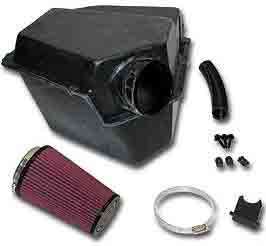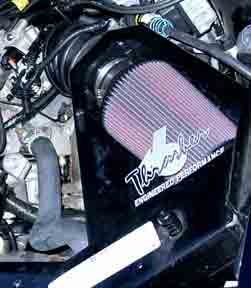Cold Air Induction
Generally speaking, colder intake air means more power. Similarly, less intake restriction also translates to more power. If you look at the Air Intake System How-To article, you will see what we are up against. While the intake is behind the headlight, a pretty cool source of air, the flow path is restrictive. One solution is to remove the stock air box and replace it with a cone filter. While this will increase the flow, it would be drawing air from the hot engine compartment.
The next step would be a Cold Air Induction system. Basically, it shields the air intake from the engine compartment. Ideally you would want to direct air from outside of the engine compartment to the air filter. But I don't know too many people who are willing to cut a hole in their hood for a scoop.
There are a number of different CAI systems out there that will fit W-bodies but I only seriously considered the ones from Thrasher and SLP.

|

|
SLP
|
Thrasher
|
What are the differences between the two? The SLP kit relocates the PCM into the air filter housing. The Thrasher kit has a bracket that mounts the PCM under the airbox. The Thrasher unit has a clear window while the SLP one does not. Both use a rechargable cone filter.
I have been told that SLP stated that their unit will not fit the Impala because some of the mounting clips do not line up. However they do say it will fit the Monte Carlo so I don't know what to make of that.
Jay installed the SLP CAI in his 2000 Impala sedan equipped with the 3.4L engine. This is what he had to say:
"I had to loosen one of the support mounts (the one over the air box) to get the old one out, and new one in. The new box is about 20% larger, and does not fit into the body as well as the old one. It took two of us about 30 minutes to do the swap due to the intake line distance is now about 3/4" to 1" shorter and took some work to put on. There was no replacement in the SLP kit.
"The PCM was a pain, too. The cable run is secured lower down on the inside of the radiator mount and is hard to see. If you open that clip, its much easier to move the wiring harness around. The PCM was taped very tightly, and some of the tape had to be removed to get the flexibility to move the PCM into its new position. It moved from the bottom of the air box to the leading side of the air box, standing on end.
"There is one point I'm unsure of: the cone filter end comes in contact with the PCM. This makes securing the cover a little tricky. I'm not sure that's right, but there's no more wire to change the angle of the PCM. The instructions are incredibly vague.
"All-in-all, its OK. There's a very slight, but perceptible whistle from the front now (not unpleasant), and a bit of a kick in the pants under hard acceleration."
Drew purchased the Thrasher CAI system from 3800 Performance and installed it in about and hour and a half. He said it went in really well. It came with a S&B filter (similar to K&N) and included all the hardware required for installation. There is only one bracket and it lined up with the existing holes. No modifications were required. He also says that it is 100% reversable just in case you wanted to take the car in for service and didn't want any questions from the dealer. The only qualm he had was that the PCM is not bolted down. It is held in place by a rubber mat and the box. But he says that it doesn't look like it will shift. If it really bothers you, some velcro would hold it down nicely.
What about performance? Drew says he can feel the difference in that it pulls strongly throughout. Off the line acceleration is not really affected, but after getting to 2300-2500 RPMs there is no drop off like before. He feels that he gained the 7-10 HP estimate that Thrasher quotes and says that it is a good upgrade for the Impala.
I will probably go with the Thrasher unit. I'll admit, the clear window is a strong selling point for me especially since both the SLP and Thrasher unit are almost the same price.
My thanks goes out to Jay, Drew and Danny for this article.



